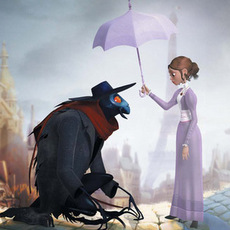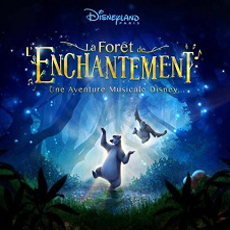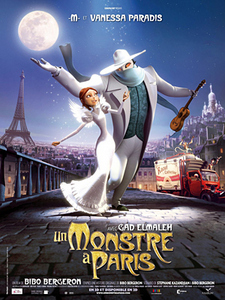 This week, Shout! Factory released A Monster in Paris into stores, with a Blu-ray 3D combo pack. Animated Views launched a contest for the title last Friday, and now we are pleased to present more assets for this charming, critically-acclaimed film, including press release interviews with director Bibo Bergeron and French singer/actress Vanessa Paradis.
This week, Shout! Factory released A Monster in Paris into stores, with a Blu-ray 3D combo pack. Animated Views launched a contest for the title last Friday, and now we are pleased to present more assets for this charming, critically-acclaimed film, including press release interviews with director Bibo Bergeron and French singer/actress Vanessa Paradis.
A Monster in Paris tells of a wacky inventor, his camera-crazy best friend and a madcap monkey who make a massive mistake in a mad scientist’s laboratory. With potions spilling everywhere, the troublesome trio accidentally creates Franc, the product of a reaction between a common flea and one of the scientist’s mystery concoctions. What they fail to realize, however, is that this “monster” is actually a soft-centered soul with an astounding talent for music.
With the help of the enchanting nightclub singer Lucille, Franc becomes the talk of the town, just as stories of Paris’s newest monster attract the attention of the egotistical police commissioner, who is obsessed with securing a big prize to help his battle to become mayor. The unwitting scientists and the singer must team up to protect Franc, a monster with more than a musical career to protect!
A Monster in Paris was produced by Luc Besson’s EuropaCorp and Bergeron’s Bibo Films. The film’s voice cast includes Vanessa Paradis, singer/songwriter Sean Lennon, Catherine O’Hara, Adam Goldberg, and Danny Huston.
An interview with Bibo Bergeron
Director Bibo Bergeron began his career in animation by working on Asterix in Britain and Asterix & the Big Fight, in his home country of France. Afterward, he moved onto such films as Universal’s Fievel Goes West, Fox’s Ferngully: The Last Rainforest, and Disney’s A Goofy Movie. At DreamWorks Animation, Bergeron co-directed The Road to El Dorado and Shark Tale. In October 2011, he unveiled his latest directorial debut, A Monster in Paris, which he dedicated to his father. A Monster in Paris finally hit the U.S. film festival circuit last year, where it received high marks from critics.
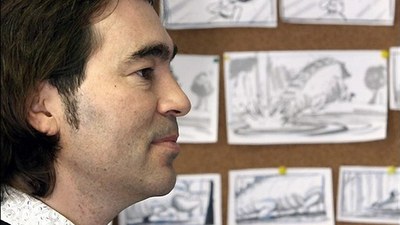
Q: When and how did the Monster in Paris adventure begin?
BB: It goes back quite a few years, to before Shark Tale. I’d been living in the USA since 1997, and this project came out of a kind of nostalgia for Paris. I wanted to make a movie about my city, a romantic movie that flirted from time to time with the horror codes. As a moviegoer, without being a total fan, I’ve always enjoyed the romantic aspect of horror movies. I also wanted to focus on the early 20th century, an incredibly effervescent period when science and technology was revolutionized — the automobile, trains — which has always fascinated me. That’s how I came up with Raoul and his constant desire for progress. Also, from the very beginning, I envisioned a very musical movie. Actually, to sum it all up, I put into the movie everything I like in a movie.
Q: How did you pull these different strands together to structure the movie?
BB: In my mind, the basic plot always revolved around the character of the monster. The first big question, therefore, was what the monster would look like. Initially, I saw him as a kind of vampire, but it wasn’t very appealing for kids, so I left the bloodlust to one side and came up with the idea of a flea that becomes bigger than human-size as the result of an experiment. Stéphane Kazandjian and I then built the script around that, using all the research I had accumulated on the period and the famous mobile police units, the Tiger Brigades. Of course, the first draft overflowed with characters and situations, so the next step was to pare the best parts down into a 90-minute movie.
Q: Why did you ask Stéphane Kazandjian to co-write?
BB: In August 2005, I’d written an outline and rough draft of the script. To move it forward, I needed and wanted other people’s input. That’s how I met Stéphane. We got on right away. He’s the yang to my yin. For example, he knows how to channel my ideas because I always tend to have too many. So we worked hand in hand from fall 2005 and finished the first “filmable” draft in summer 2006.
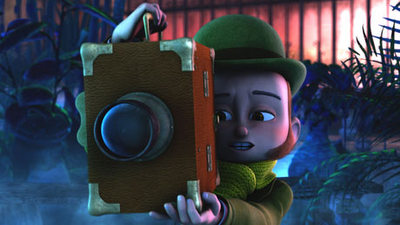
Q: At the same time as the songs – that constitute the kind of backbone of the movie – were being written?
BB: Actually, the songs were my first priority on this picture. I didn’t want to tack them onto the completed script, but for them to be an integral part of the plot. So, it’s no coincidence that the first person I invited to work on this project was Matthieu Chédid, well before the first draft of the script was ready. I called his agent and had lunch with Matthieu in October 2005. I explained my vision of the movie, and he immediately bought into it. Two weeks later, he asked me to stop by to listen to the first song, which he had already written: when Francoeur meets Lucille and sings about how it feels to be unloved. That was an important number for me because it defined the monster’s character — an angel in a monster’s body — from the start. Matthieu had done a great job. In fact, you can hear that first demo tape over the end credits of the movie. Matthieu is truly amazing!
Q: Why did you approach him first?
BB: I lived in the USA from 1997 to 2005. I’d taken a case of my favorite CDs with me, but I continued to buy French artists’ records by mail order to keep up with what was going on. That was how I ordered Matthieu’s first albums. And the photos in the liner notes of his Je dis aime album really triggered something for me, just as I was writing the first lines of the outline. The sentence “Francoeur is an angel trapped in a monster’s body” fitted just perfectly the character of M that Matthieu had created, with his hair like devil’s horns, his pink costume, his face and his angelic voice.
Q: After that, how did you work together to create the soundtrack?
BB: We talked a lot. Matthieu was hungry for all the details I had in my mind. They inspired him for the lyrics, which he sent me. Overall, he immediately grasped where I was going with the movie — the romantic mood, the affection for the characters. I can’t say it enough: meeting Matthieu was a crucial moment in the conception of A Monster in Paris. After that, everything just flowed together.

Q: At what point did Vanessa Paradis arrive to bring Lucille to life?
BB: After Matthieu, Vanessa was the second person I brought onto the project. In fact, getting their agreement so early helped me use their very strong personalities when writing the characters of Francoeur and Lucille. I think it shows through in the movie. Matthieu helped me contact Vanessa. The very first time we met, he asked me who I envisioned to voice Lucille. I explained that I wanted somebody who sang as well as she acted, and so there was only one name that came to mind: Vanessa Paradis. To me, she represented everything I wanted Lucille to be: spiky, not afraid to speak her mind, with that incredible aura that means even when she bawls you out you love her for it. It turned out Matthieu was seeing Vanessa the next day to record tracks for The Pink Soldier. He invited me along and introduced me to her. Soon after, Vanessa was on board, and she recorded the songs for A Monster in Paris before the first album she made with Matthieu. In real life, Matthieu and Vanessa have the same kind of brother-sister relationship as Francoeur and Lucille, based on their love of music. What more could I want for the movie?
Q: So the songs were recorded before you started the animation process, but what about the other voices?
BB: EuropaCorp asked me to record the voices for the English-speaking version of the movie before we started animation. This was hardly a novelty or a challenge for me because it was how I’d worked on my first two movies. So I cast my American voices and flew out to L.A. to record them. We recorded the French voices after the animation phase.
Q: When did you start work on the actual animation process?
BB: As soon as we had our first draft of the screenplay down in summer 2006, we started work on visual development: character design, sets, props and cars, and testing different colors. All in all, it took 18 months. Then, in early 2009, we went into production, and I finished the movie late August 2010.
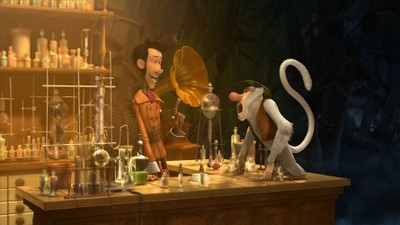
Q: Was it a tricky film to finance?
BB: Making animated movies always takes time. Three and a half years for The Road to El Dorado. Four and a half years for Shark Tale. This time, it was the same deal, except for one minor detail: I had to take a nine-month break because we couldn’t find the money to make the movie as we imagined it. It’s very difficult to convince people in France to fund a movie of this scale and budget. At one point, I couldn’t pay peoples’ wages…
Q: Were you worried you’d have to give up?
BB: Never. I was lucky enough to have people with broad shoulders and steely personalities who were behind me all the way. I had such a precise picture of the movie in my mind, I was sure I’d see it through.
Q: What were your inspirations for the mood of A Monster in Paris? The comic book artist Tardi comes to mind.
BB: I’m a big fan of Tardi’s, but he wasn’t really a reference for this movie even though we’re fascinated by the same period in history. In fact, my major inspiration, in terms of writing and drawing the characters, is Franquin. I also kept in mind the work of the late-19th and early-20th century Impressionists, such as Alfred Sisley, for their ability to inject brilliance into fog, and play with colors and light. For the story itself, I was inspired by movies like The Sucker, The Easy Life and Hothead because the characters are so likable despite all their flaws. We were aiming for the polished writing that’s a major part of my movie culture.
Q: Would you have been able to make A Monster in Paris before The Road to El Dorado and Shark Tale? How did the experience of making those two movies help you?
BB: On various levels. Sure, doors open more easily once you’ve made a $360 million grossing movie. Professionally, having the opportunity to work with leading figures in the industry and a boss like Jeffrey Katzenberg at a studio like Dreamworks taught me every day for eight years how to do my job properly and, more specifically, how to give life to an idea in my head.
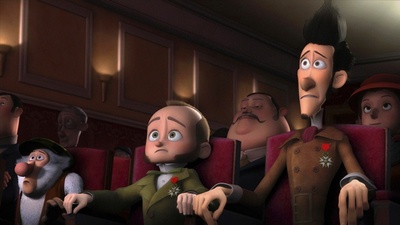
Q: Was it important to you to make A Monster in Paris in France?
BB: Yes, that’s what brought me back. I wanted to make it in France and co-produce through the studio that I created in 1993, Bibo Films. There’s so much talent here that I couldn’t imagine it as anything but a French movie, even though among the 140 people in the crew there’s a bunch of other nationalities — Spanish, Dutch, Hungarian…
Q: One of the film’s strong points is its rhythm. It’s obviously crucial to find that rhythm before animation, so you only shoot what you can use, without having to cut it afterwards. Was that complicated to achieve?
BB: Absolutely. I wanted to make this movie without leaving a single finalized scene on the cutting room floor. To achieve that, you work on the rhythm beforehand by storyboarding every scene to decide what will make the final cut and, sometimes, to ensure that rhythm is there, removing scenes you love. To make those painful choices, we produce an animatic of the storyboarded film using voices that my friends, family and I record. We watch the whole thing and decide what to cut. It doesn’t matter if you lose things at that stage because the cost is minimal. But once we’d all agreed on the storyboard, we decided to keep everything.
In the U.S., it’s different: waste is budgeted for, to a certain extent. On Shark Tale, for example, the producers knew that if Will Smith came up with a retort to a Jack Black line we’d have to extend the scene, even if we decided not to keep it in editing. On that film, whole shots sometimes ended up in the trash. In France, you can’t do that. In the end, it’s not such a bad thing because it’s always sickening to trash scenes that a whole bunch of people have put their heart into creating. It doesn’t stop you [from] refining some scenes, of course, but the completed movie is basically frame-for-frame in the storyboard.

Q: What does 3D change in the process?
BB: It’s longer and more expensive! In practical terms, it extends the process by three months. 3D came along halfway through, so we were able to plan for it. I wanted a 3D effect that never tries to be spectacular, but adds layers of depth to the atmosphere I always wanted to create. I wanted to avoid the showy or flashy aspects of 3D, so that it wouldn’t distract the audience from what is essential to the movie — characters, story and dialogue. In the end, we have a 3D that is very “theatrical,” subtle and accessible, and consistent with the movie I had in my mind’s eye. Even the jokes work on a very human level, which is what makes them funny. Similarly, I didn’t want to sprinkle A Monster in Paris with references to other movies. There is one, to The Sucker, which reflects my love of Bourvil’s movies, in the scene where a police officer with a voice like Bourvil’s has his bicycle stolen. But in the end, in writing and making the movie, my principal concern was its humanity.
Q: What now appears to have been the most complicated part of the whole adventure?
BB: In terms of funding, the most complicated thing was explaining my vision of the movie to people who weren’t artists. Without images, they didn’t understand where I wanted to take it. Was it going to look like a Pixar movie? A Dreamworks movie? I explained that it would be neither; there would be a slight painted feel to the settings. The characters would be more caricatured than in American movies, and the overall feel would be impressionistic, but not too much… In the end, I got through to them.
In artistic terms, the most complicated thing was undoubtedly the design of the monster. It wasn’t very complicated to draw a pretty singer who looks like Vanessa Paradis because I could fall back on human references, as with most of the other characters. Conversely, we really struggled to create a giant flea, dressed like Aristide Bruant, with the charm of Matthieu Chédid.

Q: How did you get there in the end?
BB: I asked several friends — illustrators, comic book artists, storyboarders — to sketch Francoeur from the description of the character I gave them. Suddenly, it dawned on me… If you look carefully, Francoeur’s face is heart-shaped. It occurred to me that this was no coincidence. It’s very symbolic that this heart-shaped face looks at us with its big bright eyes. Another graphic artist gave me the idea for the grasshopper look. And I came up with the idea of dressing him like Aristide Bruant. So, Francoeur embodies a meeting of various creative minds.
Q: A Monster in Paris is your most ambitious movie in terms of budget, story and filmmaking. You produced it through your own studio. Are you more nervous than usual prior to its release?
BB: I made the most honest movie I could. Now it’s down to audiences liking it or not, falling for it or not. It’s out of my hands. All I can say is that I made the movie I wanted to make and that it’s my most personal movie so far. Let’s be clear: I put all my heart and ability into Shark Tale and The Road to El Dorado, but they were both studio pictures. For me, A Monster in Paris is above all an arthouse movie. If it is also seen as a multiplex picture, I’ll be more than happy to have made an arthouse picture for multiplex audiences!
Q: In the end, has it remained faithful to your initial vision of the story?
BB: It’s definitely grown! It’s like any idea — you sow a seed, which blossoms and grows and gives fruit. The story has evolved a lot. The first draft featured the Tiger Brigades, France’s first mobile police units, but they’ve gone. Lucille wasn’t a cabaret singer but a police photographer. She became a singer so the singing monster could be attracted to someone who also sings. A Monster in Paris is very different in the detail but totally faithful to what made me want to make it.
An interview with Vanessa Paradis
Vanessa Paradis is a French singer and actress. She has won acclaim for her performances in the movies The Girl on the Bridge and Café de Flore, while tearing up the international music charts with hit singles including Joe le taxi, Be My Baby, and Divine Idylle. Paradis can now be heard as the protagonist Lucille in both the English- and Spanish-language versions of A Monster in Paris, performing her own singing in the picture as well.

Q: How did Bibo present the project to you?
VP: Actually, it was Matthieu Chedid who first mentioned it, a few years ago. He had been contacted to write the music and lyrics for the film’s songs. I didn’t meet Bibo right away — we just talked on the phone at first. He told me the story of the movie and explained the context: Paris in the 1900s, the flood, the cabarets… I’d really enjoyed his earlier movies, and I read the script as soon as it arrived.
Q: So you were involved very early in the process?
VP: Yes. It’s the first time that, as an actress, I’ve come in on an animated movie so early in the creative process. On A Monster in Paris, I followed everything right from the very first graphics that are supposed to capture your facial expressions and movements. We started by recording the songs in studio with Matthieu. Bibo has a very good ear for music, and he was delighted with Matthieu’s work. Then, we got to work on the speaking voice of Lucille, the female character he had created from scratch.
Q: Could you describe Lucille to us?
VP: Lucille is someone who tries to do the right thing without upsetting anyone while remaining her own woman. She’s both constrained and independent. She runs a cabaret, which involves a lot of responsibility and pressure, and she has quite a bossy aunt who likes to be obeyed and wants Lucille to be a goody-two-shoes. But Lucille still manages to do pretty much as she pleases. Above all, she loves being on stage. When she’s up there singing, it’s as if she were escaping the routine and restrictions of her daily life. Which could explain why Bibo drew her stage costume with wings…
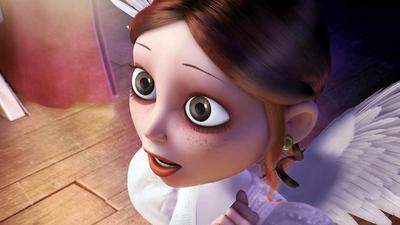
Q: From time to time, do you also have to adopt this goody-two-shoes attitude that is demanded of her?
VP: We all, including me, have to make efforts and compromises to live in harmony with each other, but my situation is not at all the same as Lucille’s. And Lucille is not such a goody-two-shoes: she is generous and sensitive and thinks with her heart first and foremost. That’s why she’s the first person to see beyond appearances and glimpse the magnificent soul that Francoeur possesses beneath his outer monstrosity. She helps and protects him when the police are on his heels, but the monster also gives her so much. When they are on stage together, she takes wing.
Q: In the movie, you speak and sing both in French and English. How did the recording of the voices go? Did you work in both languages simultaneously?
VP: In 2005, we started by recording the music and songs in French. For the spoken text, we also started with the French version, before moving onto the English version. It was only much later that we recorded the songs in English.
Q: Does it feel different? Did you find different inflections in English and French?
VP: The musicality of the two languages isn’t the same – the emphasis is different – but the sense that you give to a line comes from the words and so it remains identical.
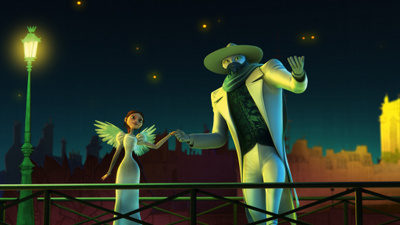
Q: How did you “find” Lucille’s voice? Did the images help you build your character?
VP: When we started work on the movie in 2005, there was just the script without images or anything. So, the creation of the character came from the voice and her motivations. From that point on, voice and image constantly informed each other, with the voice taking the image in one direction, then the images forcing us to be more precise in our interpretation and understanding of motivations, and so on. The whole piece developed out of this dialogue. The film grew out of nothing, like a cathedral. It was really interesting.
Working with Bibo was fascinating. In animation, your performance can be much more over the top than in a regular movie, especially as speaking lines without being filmed removes a lot of pressure. You’re not thinking about hitting your marks and where the camera is. Animation relies more on instinct, and Bibo gave us a lot of freedom. He drew us into a playful, fun environment – exaggerated but never ridiculously so. He is very precise and always manages to capture the pitch and subtlety you associate with non-animated movies.
Q: Just like Lucille, you have sung in cabarets. Do you still enjoy that?
VP: It’s what I enjoy most. I have been lucky enough to perform in all kinds of venues, and cabaret and theater is what I like most. I like old things — wood, sculptures, velvet — and you find all that in a cabaret. They are venues on a human scale where the audience often forms a circle around you. You feel the whole space wrapping you up. And cabarets have a soul. So much goes on there — what you experience on stage and what happens backstage, in the dressing room and wings. I like to picture the people who have been there before me — the showgirls and their costumes. It gives me a bigger thrill than any modern, steel venue ever can.

Q: Who were your heroes when you were little?
VP: My heroes were, and still are, Gene Kelly and Fred Astaire. I admire their talent as dancers, their charisma and stagecraft. They were so overwhelming, they could make me cry tears of joy and emotion. They inspired me to do what I do now. Then there was Marilyn Monroe, for the woman she was — her voice, attitude, body, strength and vulnerability, and her intelligence.
Q: Did any monsters scare you? In cartoons, movies or books?
VP: The monster I found most scary when I was little was the invisible monster that followed you down the hallway at night when you came out of your room. As if by chance, he was always behind you. He’s not particularly impressive, with no face or body — an invisible force in the dark. Apparently, it’s very common for young children to be scared by that.



